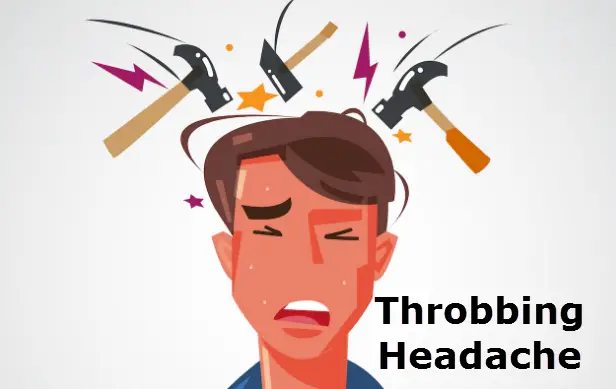What Does a Throbbing Headache Mean?
A throbbing headache is basically a sensation of explosive, pounding, pulsating, or rhythmic pressure in your head. The problem may affect a part or the whole of your head. Each person experiences the pain differently, in other words, it is subjective. Some people might also describe throbbing headaches to be sharp, burning, dull or squeezing in nature.
Throbbing headaches are quite common and affect people no matter their age, gender or ethnicity. A throbbing headache is often linked to caffeine withdrawal, migraine headache, and hangovers. However, a headache may accompany various other conditions, for example, a cluster headache, stress headache, or sinusitis (inflammation of sinuses). In some cases, serious conditions like stroke, brain tumor, bleeding inside the brain as a result of a head injury, and meningitis can lead to throbbing headaches.
Unending headaches that recur or are severe, for example, cluster or migraine headaches, can usually be treated well with regular medical attention as well as following a treatment plan.
Contents
What Causes Throbbing Headache?
Throbbing headaches may be caused by many various mild or serious diseases, conditions or injuries. Common causes include:
- A cluster headache
- Caffeine withdrawal
- Allergies
- Common cold or other respiratory diseases
- Hangover
- Ear infections
- A hormonal or a menstrual headache
- Low blood sugar
- Mild dehydration
- A migraine headache
- Muscle tension in the neck, shoulders or jaw, which may lead to a tension headache
- Inflammation of sinuses (sinusitis)
Serious/Life-threatening Conditions Causing a Throbbing Headache
Throbbing headaches may also be brought about by serious health conditions that should be evaluated immediately by a doctor as an emergency. Serious causes include:
- A brain aneurysm, a weak area in your bulging brain blood vessel that may rupture and bleed
- Brain hematoma or hemorrhage, bleeding that occurs in the brain as a result of stroke, taking blood thinners or head trauma/injury
- A brain tumor that causes pressure inside the head (Brain Tumor Headache Characteristics)
- Encephalitis, inflammation in the brain mainly caused by infection
- Shaking off a baby’s head or head injury
- High blood pressure
- Hydrocephalus, too much fluid inside the brain
- Seizure disorder
- Meningitis
Symptoms Of a Throbbing Headache
A throbbing headache may come with other symptoms. The symptoms can vary according to the underlying disease, condition or disorder, age, as well as other factors. Some symptoms can include other symptoms of the nervous system, or symptoms of other body systems, like the digestive tract. For instance, vomiting, nausea, visual changes and other sensory changes can come with a migraine headache. A migraine headache is often confused with a sinus headache. But your doctor will in all likelihood be able to differentiate a migraine from a sinus headache depending on your medical history and symptoms.
Symptoms That May Accompany Throbbing Headache
Aura, a visual disturbance as well as other sensory change which occurs in some people shortly before the start of a migraine headache.
Difficulty concentrating.
Chills.
Inability to pop the ears or an earache
Facial pressure or pain, often as a result of sinusitis
Flu-like symptoms like fever, sore throat, fatigue, cough, headache, pains, and aches
Lightheadedness
Mood changes like depression or irritability
Vomiting and nausea
Sensitivity to noise or light commonly associated with a migraine headache
Postnasal drip, runny nose, or stuffy nose
Sudden, great fatigue as well as need to sleep in a quiet, dark room. This symptom is also quite common with a migraine headache.
Managing Throbbing Headache
Here are some ways on how to manage a throbbing headache.
Consult your family doctor
A headache you are experiencing could have more serious causes that must be addressed; hence, you must visit your doctor first for a consult regarding your condition. Aside from assessing your condition, the doctor will also prescribe you with medications that you could use to address a headache. Some of the pain relievers that could be prescribed include nonsteroidal anti-inflammatory medications such as Tylenol or non-opioid analgesics such as paracetamol.
Perform progressive muscle relaxation and massage
Massaging the face, neck, and back gently could calm down muscles and may provide pain relief. Upon massaging, gently press acupressure points such as the base of the skull or the temples using circular strokes. This massage provides pain relief from a headache. On the other hand, some enjoy foot massage as it gives comfort. Enroll in yoga or meditation classes since these activities provide over-all relaxation that could help in managing headaches.
Take in vitamin supplements
Supplements that provide vitamin B-complex aid in giving persons with throbbing headache relief from pain.
Stay in places with minimal sensory stimulation
Rest in a quiet, dimly-lit room. You could use pillows to support your head comfortably.
Apply a cold compress
You could use ice packs and place it at the back of your neck or to the area where you could feel the pain.
Before the condition leads to more serious health conditions, it is necessary to take steps to address headaches. The ways on how to manage pain is already shown to you. Just follow the advice of your doctor, relax, and pamper yourself even for a while so that a throbbing headache you are enduring would go away.


